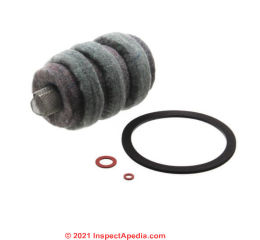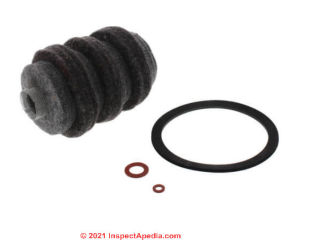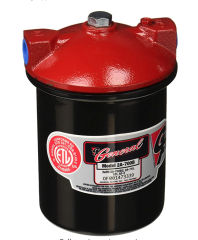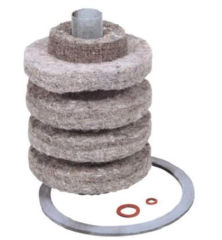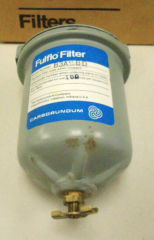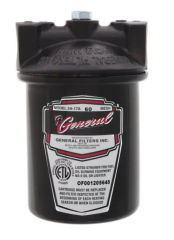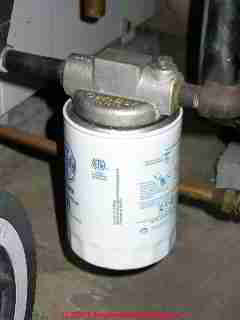 How to Change the Oil Filter Cartridge on an Oil Burner
& How to choose the right oil filter cartridge size
How to Change the Oil Filter Cartridge on an Oil Burner
& How to choose the right oil filter cartridge size
- POST a QUESTION or COMMENT about installing, servicing, and repairing oil filters used on oil-fired heating equipment & water heaters
Heating oil filter change:
Step by Step Oil Filter Change Procedure. This article series describes the installation, use, maintenance, and repair of oil filters used on oil-fired boilers, furnaces, and water heaters.
We discuss tracking down air and oil leaks at or near the oil filter canister and we describe proper oil filter location and problems to check for during oil filter cartridge changes.
InspectAPedia tolerates no conflicts of interest. We have no relationship with advertisers, products, or services discussed at this website.
- Daniel Friedman, Publisher/Editor/Author - See WHO ARE WE?
How to Change a Heating Oil Filter: Step by Step Procedure for Servicing the Oil Burner Oil Filter Cartridge
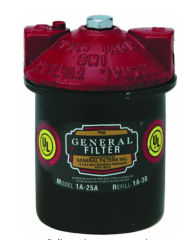 The oil filter cartridge should be changed during oil heating equipment annual cleaning, service, and tune-up.
The oil filter cartridge should be changed during oil heating equipment annual cleaning, service, and tune-up.
You should not have to change oil filter cartridges more often. If the cartridge clogs and leads to service calls or heat loss between annual service calls then we suspect the oil tank is contaminated with water or sludge - problems that need to be corrected at the oil tank.
Illustration: the General 1A-25B heating oil filter canister, used on many domestic oil burners. This canister or "container" receives the General 1A-30 oil filter cartridge or an equivalent.
[Click to enlarge any image]
The procedure for changing the oil filter cartridge is simple, but if it's performed improperly you could be left with no heat.
- Turn off electrical power to the heating appliance (boiler, furnace, water heater) whose oil filter is to be serviced
- Place a catch pan or basin below the canister to catch any oil spills or drips
- Turn off oil supply to the system by closing the fire safety valve that should be located between the oil filter and the oil feeder supply line from the oil tank.
If the valve is a fire-safety-valve it includes a spring-loaded fusible link that closes the valve in case of fire.
These valves work in the opposite direction from conventional plumbing valves. Screwing the valve top out or counter-clockwise closes the valve. - Remove the oil filter canister base:
For oil canisters with a center bolt such as the unit shown just above, loosen the bolt found in the center of the canister top and remove it.
Take care not to lose the fiber washer that seals the canister bolt and take care not to lose or damage the O-ring that seals the canister base to the canister lid.
Watch out: for oil filter canisters that are supported only by oil piping you'll be wise to support the canister lid or assembly whenever loosening parts.
Otherwise you may twist, bend, and cause leaks in the oil supply piping. Use two wrenches to loosen or tighten the canister bolt: one on the bolt itself and one on the rectangular projection at the canister lid inlet or outlet side. Leaks here cause oil burner startup bang, puffbacks, loss of heat. Details are
at OIL SUPPLY LINE PIPING LEAKS.
Watch out: the canister bottom may simply fall off at this point - you will want to catch it to avoid unnecessary oil spillage. Other oil filter canisters may lack the bolt and may have to be opened by un-screwing the canister base from the top. - Remove dirty oil filter cartridge and place it in a plastic bag for suitable disposal along with any waste oil and sludge collected during this process.
- Clean the oil filter canister: remove any oil sludge, dirt, debris from the bottom of the oil filter canister base.
Check for water contamination in the oil tank when changing the oil filter cartridge.
Water contamination in oil tanks can be detected by examining the bottom of the oil filter canister.
If you see actual water, or more likely rusty red sludge, that may be good evidence that water from the oil storage tank has been trapped in and rested in the bottom of the oil filter canister.
For details
see OIL TANK WATER CONTAMINATION - Insert the new oil filter cartridge into the canister base.
If your oil filter replacement package included a new O-ring for the canister base-to-lid seal, use it to replace the old O-ring that we told you to save in step 4.
Our photo (left) shows a typical heating oil canister filter and the gaskets that are packaged with it.
The General 1A-30 replacement oil filter cartridge shown at the left of our photo is in most canisters inserted with the screen up where it fits into a recess in the canister lid.
This filter cartridge fits the General 1A-25B oil filter canister as well as some other manufacturer's brands of an equivalent size.
That large round gasket is used to seal between the oil filter canister top and the base.
Inside the large gasket we show two smaller ones. The smallest red gasket is used under the air bleed screw found on the top of the oil canister, and the larger red gasket is used under the mounting bolt that secures the oil filter canister base to its top. - Heating oil filter canister reassembly:
Carefully, keeping the filter cartridge centered in the canister base, place the canister base up under the canister lid in proper position. - Replace the heating oil filter canister mounting bolt
(and a new fiber washer if one was provided in your oil filter cartridge kit) to secure the canister base to the lid, tightening the bolt securely but not so tight as to damage threads. If your canister does not use a center bolt the base usually assembles by screwing in in place into the lid.
Watch out: as we warned above, for oil filter canisters that are supported only by oil piping you'll be wise to support the canister lid or assembly whenever tightening parts. Otherwise you may twist, bend, and cause leaks in the oil supply piping. Details are
at OIL LINE LEAKS - Oil Line leaks found. - Open the oil supply valve to allow oil to enter the oil filter canister and then
- Bleed air from the oil filter canister using the procedure we detail just below
at OIL FILTER AIR BLEED STEPS. Use a new fiber washer for the air bleeder screw if one was provided in your heating oil filter kit. Remember to close the bleed screw at the end of this procedure. - Turn on electrical power to the heating appliance and
- Allow the oil burner to run to assure that the system starts and runs properly.
- Leak check: Check the oil piping and the oil filter canister top, center bolt and air bleeder bolt and any nearby fittings for evidence of oil leaks.
Details of just where leaks occur at or around heating oil filters are
at OIL SUPPLY LINE PIPING LEAKS
and
at OIL FILTER LEAK POINTS.
- Dispose of heating oil: if you collected heating oil in your drip pan and see that the oil is clean you can simply pour it into your oil tank through the filler pipe. Don't pour sludge, dirt, debris into the tank however.

Bleed Air from the Heating Oil Filter Canister after an Oil Filter Cartridge Change
 Once you have installed the new oil filter cartridge inside the canister you will need to bleed air out of the canister and filter before restoring the system to service.
Once you have installed the new oil filter cartridge inside the canister you will need to bleed air out of the canister and filter before restoring the system to service.
If your heating oil tank is at a level higher than that of the filter itself this is an easy task as oil may flow from the tank through the filter without even having to run the oil burner.
But most heating service techs simply turn up the heat to cause the oil burner to turn on, bypassing the cad cell relay if necessary to keep the burner running even before actual flame ignition.
Watch out: do not try this burner-on method if you don't have the necessary training: pouring a dose of un-burned oil into the combustion chamber is dangerous and risks a puffback.
With your catch-basin below the oil filter canister, simply loosen or remove the air bleeder screw located on the canister top just before the canister outlet fitting (red arrow in our photo at left, courtesy of reader E.S.).
Then open the oil supply valve to permit oil to flow from the oil tank into the canister. You may hear or feel air escaping at the air bleeder opening.
Once you see a clear flow of heating oil at the bleeder opening you can replace the screw that closes that port.
Watch out: don't forget to include the fiber washer that seals the screw to the canister head or you may have oil or air leaks at the canister.
Tips for the Follow-Up Check for Oil Leaks After Oil Filter Cartridge Change
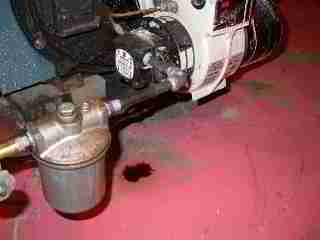 After any service procedure that disturbs oil line, filter, or burner oil piping fittings we recommend checking for evidence of oil leaks again after the system has been in use for a day or so, because slow leaks and small leaks in the oil piping system may not show up immediately.
After any service procedure that disturbs oil line, filter, or burner oil piping fittings we recommend checking for evidence of oil leaks again after the system has been in use for a day or so, because slow leaks and small leaks in the oil piping system may not show up immediately.
Clean the floor beneath and around the heating oil filter and oil piping. Check back in a day or two for fresh heating oil spots on the floor (below left).
If you leave a clean paper towel below the oil filter and connectors it can make spotting an oil drip easier.
Fix any oil leaks immediately. An air leak into the oil piping system leads to improper oil burner operation, risking a dangerous puff-back, or loss of heat in the building.
Reader Question: spin-on / off heating oil filter maintenance
10/30/2014 Anonymous said:
The furnace oil filter changing instructions are for canister and not the spin-on cartridge pictured.
Are there separate instructions for removing and replacing a spin-on fuel filter cartridge (Gar-ber, Granby, etc)?
Reply:
Thanks Anon for pointing out the need for this clarification. For a spin-on type oil filter cartridge the basic steps are the same: shut off the equipment, shut off the oil supply, place a pan to catch drips, remove and replace the filter. The central difference is that there is no center bolt to remove to drop the filter (as is the case with General Filters).
The mounting hardware for this filter is (as with other brands) specific to the filter brand, size, type. Gar-Ber filters,for example, include a die-cast metal head to which the oil lines are connected and to the under-side of which the Gar-Ber spin on heating oil filter screws on and off. The Gar-Ber filter head includes a port for a vacuum gauge and it also includes an air bleeder screw that serves the same function as we describe in the article above.
Gar-Ber spin-on / off oil filters are distributed by General Filters - generalfilters.com
Granby spin-on / off oil filters (Granby EX200-999) are distributed by Granby Industries - granbyindustries.com and also provide mounting hardware that connects to heating oil lines and that also includes an air bleeder plug. Granby also sells a traditional center-bolt oil filter as well. Granby notes that their 10 micron spin-on oil filter works with all spin-on filter heads of the same type and fit the CGF-10, Kerr K10, Purolator Per-103 and Nozzle Guard NG1500-M oil filter mounts.
Granby's instructions include this helpful note that gives some heating oil line vacuum reference points
"SERVICE: Replace the filter element at the beginning of each heating season, or when running vacuum exceeds 6’’ Hg on one-pipe systems or 15’’Hg on two-pipe systems."
...
Reader Comments, Questions & Answers About The Article Above
Below you will find questions and answers previously posted on this page at its page bottom reader comment box.
Reader Q&A - also see RECOMMENDED ARTICLES & FAQs
On 2021-03-24 - by (mod) - what is the right oil filter size for me to use?
@Gene,
You may have been confused by people mixing names for the oil filter canister - the metal container that holds the actual heating oil filter and the actual oil filter cartridge that is inserted into the canister and through which the heating oil is filtered.
In your question " I've seen the cartridges in sizes 1A25B and 1A-30. " actually the 1A25B is the name for the oil filter canister (container) manufactured by General, ,and the 1A-30 is the oil filter itself that is inserted into that canister.
For residential oil burners most use an oil filter canister (the can that holds the filter) such as the General Filter Model 1A-25A.
That filter uses cartridge refills in size 1A-30.
There are also substitute oil filters that will fit in that canister like the F15-48 that are perfectly compatible
Also compatible is the A-315 filter. What's different is the material but the size and operation of all 3 fit into the 1A-25A canister.
Some residential oil burners and some commercial burners use a larger capacity oil filter canister such as the General Model 2A-700B.
This larger canister uses as actual filter cartridge refills the 2A-710BG, or the 2A-710, 101, or RF2 oil filter cartridges.
I'll add illustrations of these oil filter canisters and filter cartridges to clarify their use.
Thanks for asking.
Above: The General 1A-25A oil filter canister and its standard filter cartridge, the 1A-30. This is the most-common residential oil burner filter size, though equivalents are available from other manufacturers.
Below: the F15-48 oil filter cartridge from Westwood, and the rather different-looking but same size Fulflo F10-209 oil filter cartridge, both of which fit and work in the General 1A-25A oil filter canister shown above.
Below: the larger General 2A-700B oil filter canister, and the General 2A-710 oil filter cartridge that fits into this larger canister.
Other heating oil filter brands
Above: the Parker Carborundum Fulflo process liquid filter model B3A-1/4" BD (Bottom drain), and next to it,
the General Aire from General Filters, Model 2A-17A similar to the General l 2A-700B above. The 2A-17A oil filter can be used with No. 2, 4, 5, an No. 6 fuiel oil. It is also used for othe roil filtering applications.
Below: the Westood heating F65 oil filter canister, also using a cast-iron top and the company's Pure-Oil filter element - filter cartridge Nos. F30-24, F35-12, F35-24.
See this
- GENERAL FUEL OIL FILTER CATALOG [PDF] (2015) General Filters, Inc.
43800 Grand River Avenue, Novi, Michigan 48375 USA, Tel: (866) 476-5101 Email: customerservice@generalfilters.cofor a more-exhaustive list of models and features of various heating oil and fuel oil filter products.
Canadian contact: Canadian General Filters, Ltd. 400 Midwest Rd. Toronto, ON M1P3A9 (888) 216-9184 sales@cgfproducts.com - WESTWOOD OIL FILTER CATALOG [PDF] (2013) Westwood Co., Tel: 1-800-442-1630
On 2021-03-24 by Gene
How do you know which size oil filter cartridge to use? Mine is the canister type with the felt insert but I've seen the cartridges in sizes 1A25B and 1A-30. There doesn't seem to be a size identified on the canister.
Thanks!
On 2020-09-09 - by (mod) -
Thanks, Matt, for a helpful question.
These fire safety valves work "backwards" from typical plumbing shutoff valves.
Turning the round handle COUNTER-CLOCKWISE (to the left) OPENS the valve. When you turn the handle to the left or counter-clockwise you'll see the valve stem rise up through the round handle.
The reason the valve works this way is that in the open position the valve stem has compressed a spring that, combined with a fusible link, will push the valve face "down" to "close" the valve in the event of a fire.
Turning the fire-safety-valve handle CLOCKWISE (to the right) will CLOSE the valve.
Doing this, you'll see the round screw stem move downwards in the valve, as the valve gate is closing.
Thanks for the discussion.
On 2020-09-07 by Matt
You said "If the valve is a fire-safety-valve it includes a spring-loaded fusible link that closes the valve in case of fire.
These valves work in the opposite direction from conventional plumbing valves. Screwing the valve top out or counter-clockwise closes the valve"
I believe it's the opposite, turning it counter clockwise opens the valve. It lifts the stem up, clockwise seats it, closing the valve.
On 2019-11-17 by (mod) - What should the gauge after the oil filter read
Deut
I'd need to see a photo to understand the exact situation, but generally if there is a vacuum gauge between the oil filter and the fuel unit (oil pump) it will show several inches of vacuum when the unit is running.
The service tech uses vacuum measurement to see if there are air leaks in the oil line or a bad fuel unit or similar problems.
A gauge on the high pressure line will read 100 psi or higher depending on how the fuel unit has been adjusted.
Watch out: pressure gauges in any location on a heating oil line or high pressure line between pump and burner should not be left permanently in place unless there are fittings to shut off oil pressure in to the gauge - to isolate it from the piping; my concern is that a burst gauge could spew oil all over and start a building fire or a leak at a gauge on the suction side of the pump may leak air into the system causing unsafe burner operation.
PLEASE read the details at OIL LINE VACUUM & PRESSURE TESTS
and then don't hesitate to ask further questions.
On 2019-11-17 by deutgrass86@gmail.com
What should the gauge after the oil filter read when everything is running correctly?
My gauge is at 6 or 7 should the filter be replace? Ty Joe d
On 2019-01-22 by (mod) - Do I need to bleed the system after replacing the filter
Absolutely, Naz, air needs to be removed from the system for safe and proper oil burner operation.
On 2019-01-22 by Naz
Hello - i have no issue with my furnace other than an oil stench, it is an old system (30 years +)
I am going to replace the oil filter, but the bleed is at the burner since it is a
Carborudum FB4 filter housing. Do I need to bleed the system after replacing the filter or can I skip this step?
Thanks
On 2018-12-18 by (mod) -
Denise
I holding the upper body of the oil filter with a suitable wrench and using an oil filter canister wrench on the bottom you should be able to unscrew the filter from the present installation. If not you could replace the entire assembly with a new oil filter assembly such as that made by General.
On 2018-12-1 by Denise
 This is on so tight that I can't get it off. Do they make these kinds of filters
This is on so tight that I can't get it off. Do they make these kinds of filters
any more . How can I get it off?
Original IMAGE LOST by older version of Clark Van Oyen’s useful Comments code - now fixed. Please re-post the image if you can. Sorry. Mod.
On 2018-04-09 by (mod) -
Kevin
I replace the filter at annual oil burner service. If you find that the filter is clogging and having to be replaced more-often than that there's a problem to be found and fixed at the oil tank - at the very least by increasing the filter capacity so as to make it to annual service.
On 2018-04-09 by Kevin
Awesome info- thanks so much! How often should I replace the cartridge in my filter? Is this like a once-a-year kind of thing? Thanks in advance.
On 2016-11-14 by Vince
What if my oil filter housing does NOT have a bleeder screw but is one of the ones securing a filter with a bolt accessible from the top? Is there another bleeding method?
Also, the housing is pretty rusted on mine. Should I just replace the whole housing with a newer one?
On 2016-10-10 by (mod) -
Mike:
Use the page top or bottom CONTACT link to send me sharp photos of the oil filter housing and any labeling on it and I'll research and reply.
Daniel
On 2016-10-10 by Mike
My oil tank has a 'Commercial' brand filter housing with a flat-head screw centered into its plastic housing in place of a bolt. Can you offer a bit of guidance on how to change the cartridge?
Thanks
On 2016-08-17 by David
Thank you for your valuable instructions and also for your forward thinking warnings.
Cheers,
David
...
Continue reading at OIL FILTER LEAK POINTS or select a topic from the closely-related articles below, or see the complete ARTICLE INDEX.
Or see
Heating Oil Filter Articles
Suggested citation for this web page
OIL FILTER CHANGE STEPS at InspectApedia.com - online encyclopedia of building & environmental inspection, testing, diagnosis, repair, & problem prevention advice.
Or see this
INDEX to RELATED ARTICLES: ARTICLE INDEX to HEATING OIL, OIL BURNERS, OIL FIRED HEATERS, OIL TANKS
Or use the SEARCH BOX found below to Ask a Question or Search InspectApedia
Ask a Question or Search InspectApedia
Try the search box just below, or if you prefer, post a question or comment in the Comments box below and we will respond promptly.
Search the InspectApedia website
Note: appearance of your Comment below may be delayed: if your comment contains an image, photograph, web link, or text that looks to the software as if it might be a web link, your posting will appear after it has been approved by a moderator. Apologies for the delay.
Only one image can be added per comment but you can post as many comments, and therefore images, as you like.
You will not receive a notification when a response to your question has been posted.
Please bookmark this page to make it easy for you to check back for our response.
IF above you see "Comment Form is loading comments..." then COMMENT BOX - countable.ca / bawkbox.com IS NOT WORKING.
In any case you are welcome to send an email directly to us at InspectApedia.com at editor@inspectApedia.com
We'll reply to you directly. Please help us help you by noting, in your email, the URL of the InspectApedia page where you wanted to comment.
Citations & References
In addition to any citations in the article above, a full list is available on request.
- Audels Oil Burner Guide, Installation, Servicing, Repairing, Frank D. Graham, 1940's edition (obsolete). Updated versions of this guide are available in various editions, 1947, 1950, 1955, 1958, 1959, 1962, 1965, 1967, and at prices from around $3.00 to nearly $70.00 - useful for simple, clear, but not current, explanation of how heating equipment works. The original retail price was $1.00.
- Dave Ferris - M&S Environmental Systems, Dutchess County, New York. Mr. Ferris was an HVAC expert. Personal communication to DJF 1987. Remove the firematic or fusible oil supply line valve on return oil-line side - in case of fire if this one closes first the pump continues to run, blows its seal, and sprays oil all over the fire. Proper installation is to have a fusible link valve only on the supply side, and to install a check valve on the return line to prevent back-siphonage from the tank.
- "HUD Regulation for Manufactured Homes; Requirement that Heat-Tape not include a GFCI [ copy on file as /plumbing/GFCI_Heat_Tapes_HUD_CPSC_Letter1994.pdf ] - ", Meeting Log, US CPSC, HUD, Dennis McCoskrie, ESEE, 2/14/1994
- [1] LeakLok™ blue thread sealant compound is available from Argo, Inc., 2610 Commerce Way, Vista CA 92083, tel: 800-854-1015. Quoting from the company's product literature:
Leak Lock Blue Joint Sealing Compound 1.3 oz. tube Soft setting joint compound that seals threaded joints, gasket surfaces and mating surfaces. Resin-based brushable paste which remains permanently flexible, internal surfaces and fills voids. Excellent for use on metal and plastic materials subject to extreme vibrations. - Our recommended books about building & mechanical systems design, inspection, problem diagnosis, and repair, and about indoor environment and IAQ testing, diagnosis, and cleanup are at the InspectAPedia Bookstore. Also see our Book Reviews - InspectAPedia.
- In addition to citations & references found in this article, see the research citations given at the end of the related articles found at our suggested
CONTINUE READING or RECOMMENDED ARTICLES.
- Carson, Dunlop & Associates Ltd., 120 Carlton Street Suite 407, Toronto ON M5A 4K2. Tel: (416) 964-9415 1-800-268-7070 Email: info@carsondunlop.com. Alan Carson is a past president of ASHI, the American Society of Home Inspectors.
Thanks to Alan Carson and Bob Dunlop, for permission for InspectAPedia to use text excerpts from The HOME REFERENCE BOOK - the Encyclopedia of Homes and to use illustrations from The ILLUSTRATED HOME .
Carson Dunlop Associates provides extensive home inspection education and report writing material. In gratitude we provide links to tsome Carson Dunlop Associates products and services.


